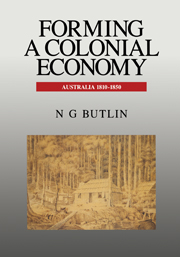Book contents
- Frontmatter
- Contents
- List of Tables
- List of Figures
- Acknowledgements
- Part I Forming an Economy
- Part II The Colonial Peopling of Australia: 1788–1850
- Part III Public Funding of Colonial Development: 1788–1850
- Part IV The Colonial Australian Economy 1810–1840—A Historical, Statistical and Analytical Account
- 11 Summary and Questions
- 12 Towards a Private Market Economy in Australia: 1810–40
- 13 Structural Adjustment and Development: 1810–40
- 14 Growth Performance: 1810–40
- 15 Instability and Economic Fluctuations with Special Reference to the Depression of the 1840s and Recovery
- Bibliography
- Appendixes
- Index
11 - Summary and Questions
from Part IV - The Colonial Australian Economy 1810–1840—A Historical, Statistical and Analytical Account
Published online by Cambridge University Press: 04 August 2010
- Frontmatter
- Contents
- List of Tables
- List of Figures
- Acknowledgements
- Part I Forming an Economy
- Part II The Colonial Peopling of Australia: 1788–1850
- Part III Public Funding of Colonial Development: 1788–1850
- Part IV The Colonial Australian Economy 1810–1840—A Historical, Statistical and Analytical Account
- 11 Summary and Questions
- 12 Towards a Private Market Economy in Australia: 1810–40
- 13 Structural Adjustment and Development: 1810–40
- 14 Growth Performance: 1810–40
- 15 Instability and Economic Fluctuations with Special Reference to the Depression of the 1840s and Recovery
- Bibliography
- Appendixes
- Index
Summary
During the 30 years from 1810 to 1840, two Australian economies — colonial and Aboriginal — were in direct contention. On the south-east mainland, in the modern New South Wales and Victoria (Port Phillip District) and in Van Diemen's Land, the confrontation was a broad one. It ended in total disaster for the Aborigines in Van Diemen's Land and with only few Aborigines remaining in NSW and Port Phillip. The outlines of this frontal encounter have been told, in terms of impact on Aborigines, in the final part of the companion volume to this one, Economics and the Dreamtime and earlier in Our Original Aggression. More obliquely, a similar if less destructive series of meetings occurred by the end of the 1820s, firstly in what is now Queensland at Moreton Bay, at Raffles Bay and Port Essington in the Northern Territory and at King George's Sound in Western Australia. These were followed by more direct but still limited farm settlement by colonists in Western and Southern Australia in 1829 and 1836, respectively.
The total collision between Aborigines and colonists was a combination of disease transmission and economic interaction. The economic outcome largely reflected a broad breakout from early colonial bridgeheads in NSW and Van Diemen's Land and partly a dispersed process of British government and private settlers laying claim substantially to the whole of Australia. We are concerned in this volume with the settlement process from a colonial point of view.
- Type
- Chapter
- Information
- Forming a Colonial EconomyAustralia 1810–1850, pp. 96 - 106Publisher: Cambridge University PressPrint publication year: 1994



